Page added on December 3, 2020
Where There’s a Well There’s a Way
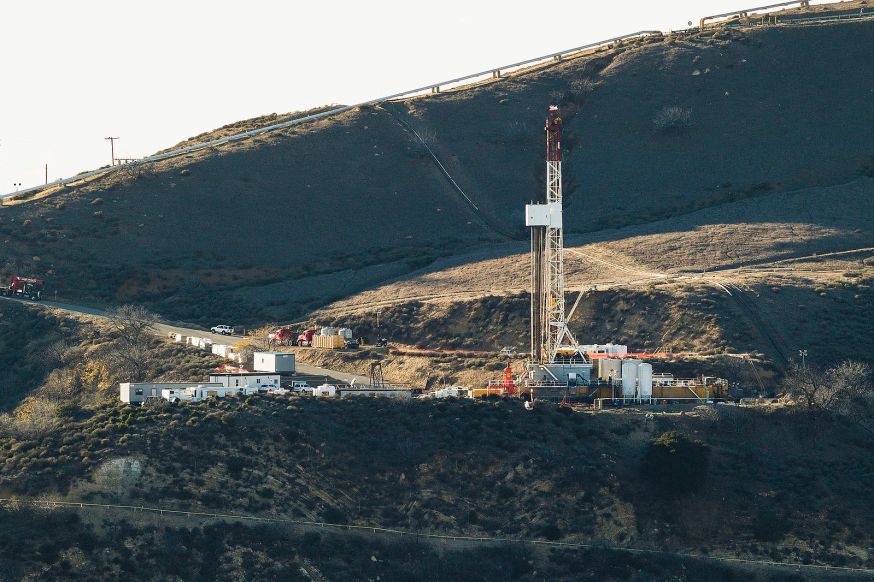
Last month, the French company ENGIE hit the brakes on a multi-billion-dollar contract to import liquified natural gas from the United States. Why the cold feet? It seems the French are understandably concerned about the climate impacts of US methane emissions.

This news helps fuel arguments that we should be doubling down (versus backing off) on regulating our methane emissions. But this is easier said than done. It’s hard to track – let alone regulate- emissions seeping from a million active wells and hundreds of thousands of miles of pipelines across the United States.
In this new Energy Institute working paper, graduate students (and job market candidates!) Karl Dunkle Werner and Wenfeng Qiu argue that new ways of detecting methane emissions could give regulators the tools they need to cost-effectively regulate emissions from natural gas wells. Before unpacking this important paper, let’s first review some mind-blowing facts about methane.
Methane math
Methane is a greenhouse gas that deserves more attention than it gets. Molecules of methane spend less time in the atmosphere than CO2, but they’re far more potent. Over 20 years, a ton of methane will warm the planet 80 times more than a ton of CO2. If CO2 adds a t-shirt of warmth to the globe, methane adds a down comforter.
Clever science-types have been hard at work developing new ways to measure how much methane leaks out of the oil and gas supply chain. Using satellites, drones, and airplanes, researchers have been collecting measurements from thousands of well pads across the country.
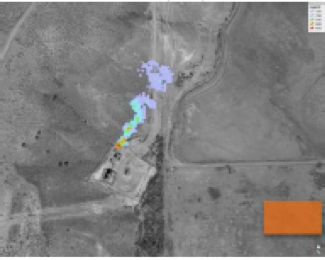
A 2018 paper scales measurements from several of these studies to a national level. The news is not good. It’s estimated that, on average, 2.3% of upstream US natural gas production is leaking. That’s more than 60% higher than official EPA estimates.
Multiply U.S. natural gas production in 2018 by a 2.3% leak rate and you get over 13 million tons of methane emissions. Make the CO2 equivalent conversion for a 20-year time horizon (think t-shirts to down comforters), and the warming impact of these gas leaks is comparable to the carbon emissions from all US passenger cars and trucks in 2018. In other words, methane emissions from natural gas production are a big deal.
Another key finding is that the majority of emissions seem to be coming from a small number of big leaks. These “super-leaks” are typically caused by maintenance and equipment failures.
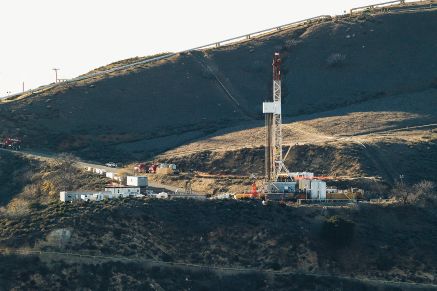
The role of super-leaks helps explain why EPA engineering estimates can significantly under-estimate real-world methane emissions. It also suggests that if more effort was invested in safe operations, methane emissions could be significantly reduced.
Firms are already invested in abatement (not enough)
The natural gas industry has been quick to point out that they are “already incentivized to prevent methane emissions”. Firms are in the business of selling natural gas which is 90% methane, so leaked gas means lost profits!
The problem with this argument is that the market price for natural gas is less than 1/10th of the per-unit environmental cost of a gas leak. If firms faced the full cost of methane leaks, they would invest more in leak prevention. How much more? This is a question that Karl and Wenfeng tackle in their paper.
They start by estimating firms’ abatement costs. They combine airplane measurements of methane leaks with data on natural gas prices and some assumptions about how firms trade off leak risks and leak prevention costs. A key assumption is that firms will set abatement costs equal to lost profits on the margin. Making this (and other) assumptions, they can back out the implied costs of leak prevention for the wells in their study:
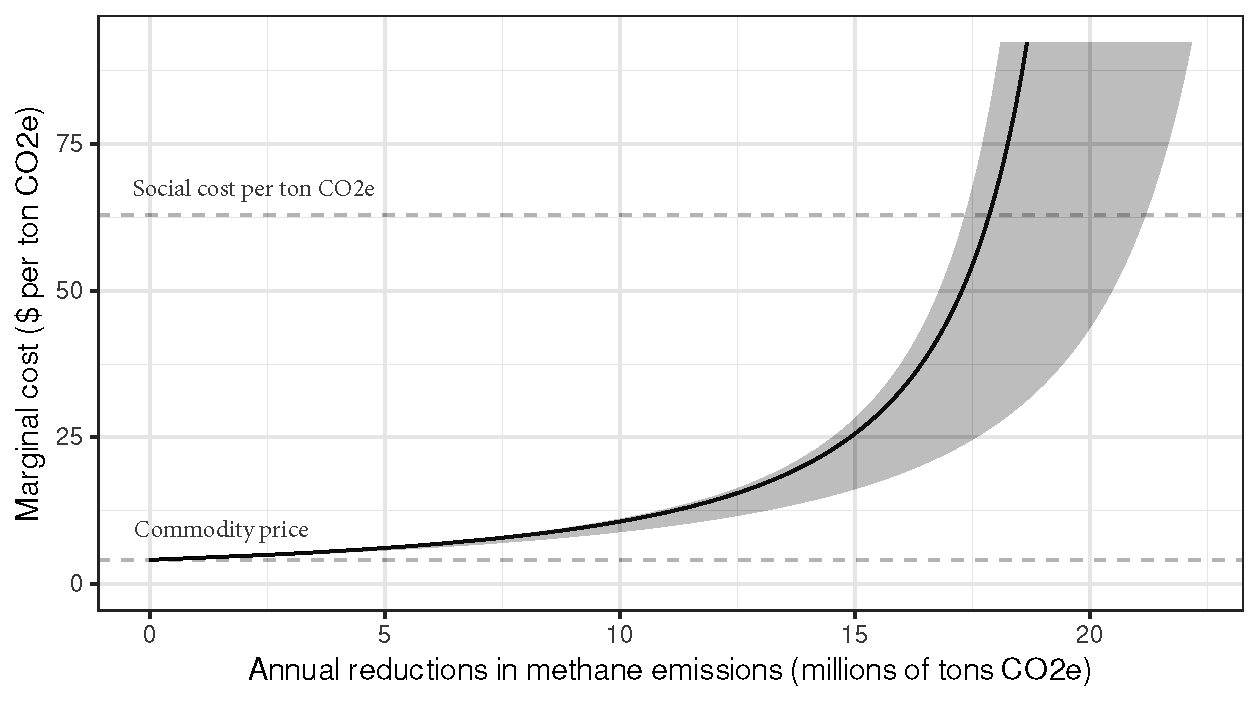
This graph is striking for two reasons. First, it seems there are lots of low-cost opportunities for methane abatement. Second, it suggests that methane leaks could be reduced by as much as 80% if these firms had to pay the full social cost in the event of a leak (although the authors are careful to note that this estimate requires extrapolating substantially beyond the costs they observe).
How to catch a leak?
The environmental impacts of methane leaks are high. Based on this research (and related work by Levi Marks), the cost of avoiding these leaks appears to be low. This situation seems ripe for regulatory intervention. Without it, firms face limited pressure to prevent leaks.
Karl and Wenfeng argue that an effective regulatory approach is one that audits firm operations and assesses fines on the basis of methane leaks detected, but it’s prohibitively expensive to continuously audit every well and pipeline. So regulators need to figure out how to target limited audits to catch the biggest leaks.
The paper considers a range of alternatives that vary in terms of targeting and the fee assessed per ton of emissions detected. I’m going to focus on three approaches, all of which impose the reality-based constraint that you can only audit 1% of wells each year.
The first approach audits facilities randomly, an audit-in-the-dark strategy. The large leaks this paper studies are rare, so leaks are detected (and fines are assessed) with low probability. Firms have little incentive to prevent leaks.
The second approach targets audits based on well characteristics like size and age. This approach does not perform much better because it’s really hard to predict when and where leaks will happen.
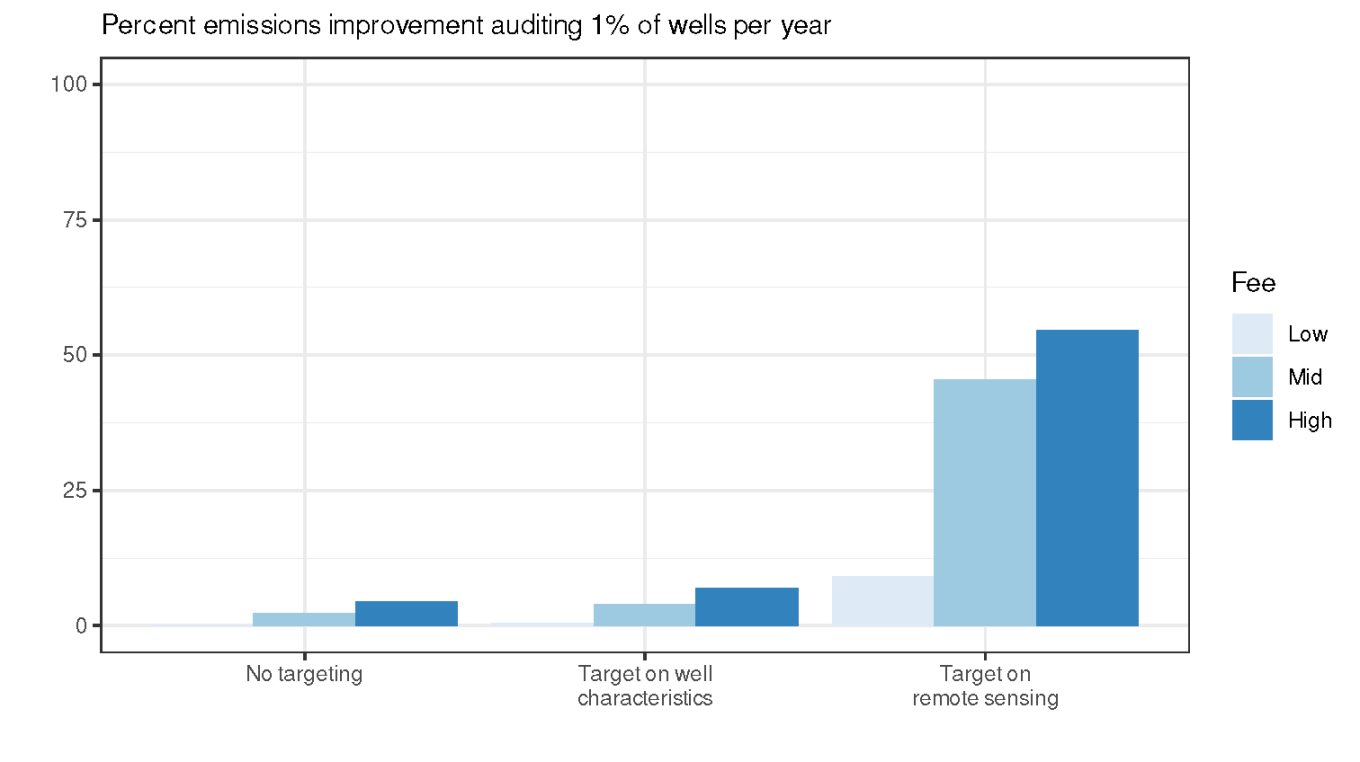
The third approach assumes the regulator can use satellite-based measurements to detect leaks above a certain threshold. When leaks are remotely sensed, regulatory staff are dispatched to audit. Simulated outcomes under this approach are promising. Better leak detection coupled with the higher fine per unit of emissions leaked gives firms a much stronger incentive to invest in leak prevention.
Where there’s a well there’s a way?
Scientific advances in the measurement and detection of emissions are changing the way we understand the methane pollution problem. To translate these measurement innovations into on-the-ground emissions reductions, we’ll also need policy innovations. This paper is an important step in that direction.
My friend Barry Rabe has argued that the main obstacles standing in the way of meaningful methane regulation in the US have less to do with measurement challenges and more to do with political challenges from energy producers. But the more we understand about unregulated methane emissions, the harder it is to see (and/or sell) made-in-America natural gas as a clean and green fuel. As these invisible emissions become more visible, can we find the political will to crack down on methane leaks?
Keep up with Energy Institute blogs, research, and events on Twitter @energyathaas.
9 Comments on "Where There’s a Well There’s a Way"


Cloggie on Fri, 4th Dec 2020 12:21 am
Consultancy McKinsey just published a report with a relatively upbeat assessment about the potential of the EU renewable energy transition. McKinsey has come to the same conclusions as the German Fraunhofer Institute had come three years earlier: the transition can be done in a cost neutral way.
https://deepresource.wordpress.com/2017/09/16/blueprint-100-renewable-energy-base-for-germany/
“McKinsey – Net-Zero Europe”
Report 204p pdf.
Wild about Wind on Fri, 4th Dec 2020 3:07 am
“Consultancy McKinsey just published a report with a relatively upbeat assessment about the potential of the EU renewable energy transition. McKinsey has come to the same conclusions as the German Fraunhofer Institute had come three years earlier: the transition can be done in a cost neutral way.”
BS, hopium of the corrupt science and academia being enabled by an accounting firm that is itself corrupt. German Fraunhofer stupidity is a joke of flying pigs and goal seeking.
Abraham van Helsing on Fri, 4th Dec 2020 4:58 am
“BS, hopium of the corrupt science and academia being enabled by an accounting firm that is itself corrupt. German Fraunhofer stupidity is a joke of flying pigs and goal seeking.”
It’s in the geopolitical interest of continental Europe that Americans keep thinking that the renewable energy transition can’t work and put them industrially at a as big a distance as possibly.
History has shown that those who master a new form of energy first, will enjoy a head start and century of geopolitical dominance.
The End of The West Latest:
https://www.dailymail.co.uk/news/article-9017657/France-threatens-VETO-bad-Brexit-deal-talks-teeter-brink.html
“France threatens to VETO ‘bad’ Brexit trade deal as talks teeter on the brink of COLLAPSE with UK complaining of last minute ambush”
The breach between Europe and Anglosphere is immanent. France is the foreign policy leader in Europe. We are turning to Russia. North Stream 2 could lead to the desired all-out trade war EU-US.
If white America doesn’t revolt, the USSR-2.0=Anglosphere will be next and Orwell would be right with his geopolitical prediction (=program?):
https://documents1940.wordpress.com/2017/09/26/which-future-world/
And apneaman’s tribe can begin with his yesterday announced “culling” of white-people-with-an-attitude. They only have to browse through the (((Google))) and (((Facebook))) files to acquire information, the NKVD of former fame could only dream about.
Wild on Wind on Fri, 4th Dec 2020 5:09 am
“History has shown that those who master a new form of energy first, will enjoy a head start and century of geopolitical dominance.”
History has shown those embracing false promises instead of reality fail
Cloggie on Fri, 4th Dec 2020 5:21 am
“History has shown those embracing false promises instead of reality fail”
This new wind farm, build in a couple of months time, is very real:
https://deepresource.wordpress.com/2020/11/30/borssele-1-2-752-mw-wind-farm-operational/
“Borssele 1 & 2 752 MW Wind Farm Operational”
How many offshore wind parks does the US have? Just as many as Nigeria or Brasil: ZERO.
No engineering competence, too much third world. All they can is burning oil and gas, like they have done for a century. And now the conventional oil and gas is running out and the fracking stuff is expensive and environmentally hazardous.
Antius on Fri, 4th Dec 2020 6:21 am
“History has shown that those who master a new form of energy first, will enjoy a head start and century of geopolitical dominance.”
That only applies if the new energy source offers economic or miltary benefits compared to what it is replacing. Ironically, fossil fuel ERoEI is declining so fast that it may come down to the choice between a wind turbine or nothing at all.
But given the low power density, intermittent nature and resultant huge materials requirements of wind and solar power systems, it is misleading to pretend that this is some kind of world beating technology. It will be a way of surviving if we really don’t have any other options.
The thing is, we do have other options.
https://world-nuclear.org/information-library/energy-and-the-environment/energy-return-on-investment.aspx
JuanP on Fri, 4th Dec 2020 6:34 am
I stopped caring about humanity’s future a long time ago once I realized it was a waste of my time and energy. Now I think that it would be best for life on Earth if we ceased to exist as a species. This is not my fault becuase I got a vasectomy.
Cloggie on Fri, 4th Dec 2020 6:52 am
The thing is, we do have other options.
https://world-nuclear.org/information-library/energy-and-the-environment/energy-return-on-investment.aspx
The last time I studied nuclear energy was in university in the eighties, lost interest since. Perhaps the latest developments have it has merits, I can’t judge.
What I DO know is that nuclear doesn’t have the essential PR and goodwill. It is seen as a sinister technology, it’s damaged goods in the eyes of the majority of the global public.
That only applies if the new energy source offers economic or miltary benefits compared to what it is replacing. Ironically, fossil fuel ERoEI is declining so fast that it may come down to the choice between a wind turbine or nothing at all.
That’s my point! In the land of the blind, one-eye is king. You gotta row with the paddles you have.
Cloggie on Mon, 7th Dec 2020 5:03 am
Growing resistance against more onshore wind in the Netherlands:
https://deepresource.wordpress.com/2020/12/07/growing-protest-against-onshore-wind-power-in-holland/
“Growing Protest Against Onshore Wind Power in Holland”